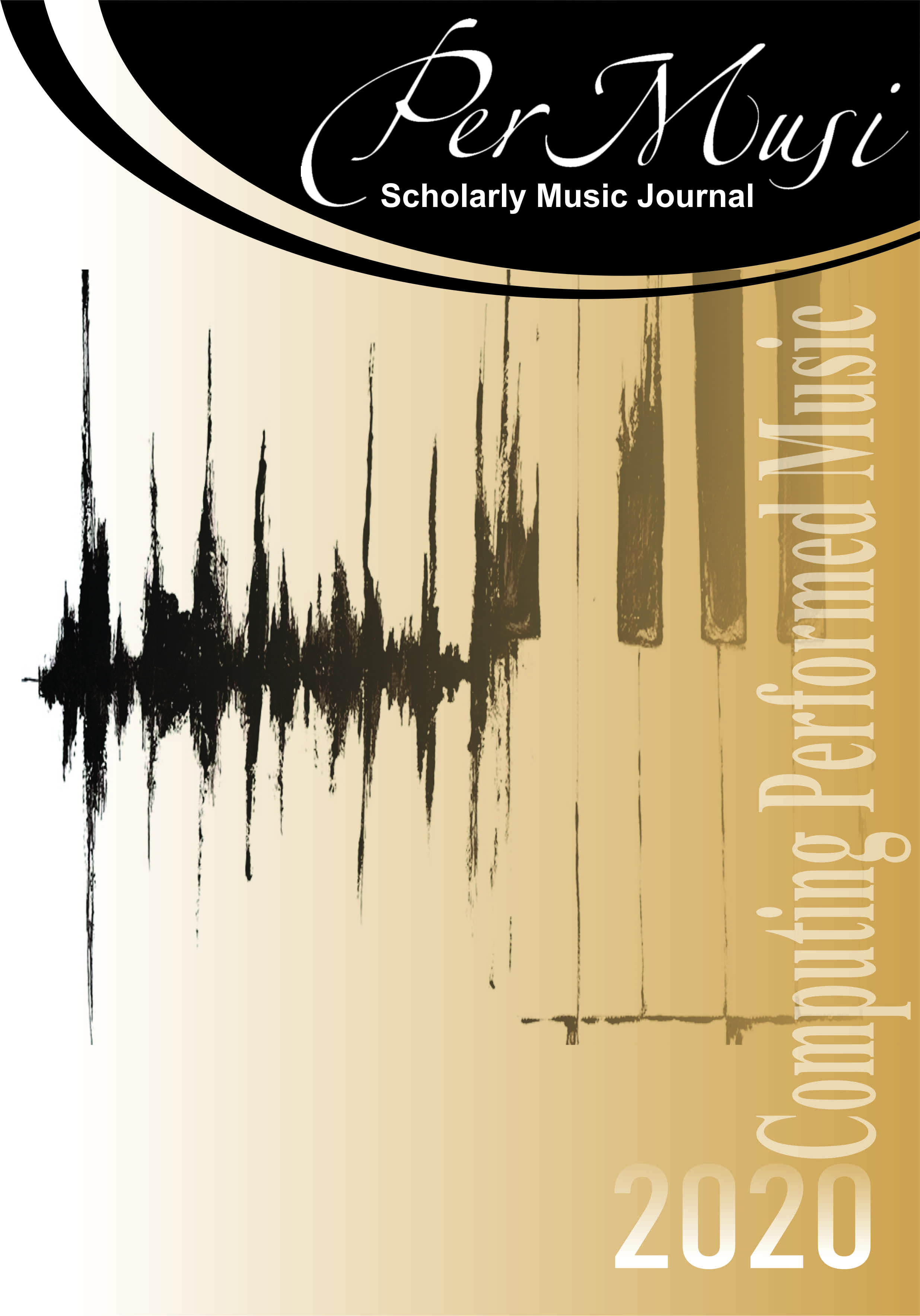TumTá and Pisada
Digital Dance and Music Instruments Inspired by Popular Brazilian Traditions
DOI:
https://doi.org/10.35699/2317-6377.2020.26151Keywords:
New interfaces for musical expression, Digital musical instrument, Digital dance and music instrument, Design process, Inspiration from tradition, Brazilian musical instrumentAbstract
This paper presents the development process of TumTá, a wearable Digital Dance and Music Instrument that triggers sound samples from foot stomps and Pisada, a dance-enabled MIDI pedalboard. It was developed between 2012 and 2017 for the use of Helder Vasconcelos, a dancer and musician formed by the traditions of Cavalo Marinho and Maracatu Rural from Pernambuco, Brazil. The design of this instrument was inspired by traditional instruments like the Zabumba and by the gestural vocabulary from Cavalo Marinho, to make music and dance at the same time. The development process of this instrument is described in the three prototyping phases conducted by three approaches: building blocks, artisanal, and digital fabrication. We analyze the process of designing digital technology inspired by Brazilian traditions, present the lessons learned, and discuss future works.
References
Barbosa, Jerônimo, Calegario, Filipe, Tragtenberg, João, Cabral, Giordano, Ramalho, Geber, and Wanderley, Marcelo M. 2015. Designing DMIs for Popular Music in the Brazilian Northeast: Lessons Learned. Proceedings of the International Conference on New Interfaces for Musical Expression, 277–280.
Cadavid, Laddy P. 2020. Knotting the memory Encoding the Khipu: Reuse of an ancient Andean device as a NIME. In Michon, Romain and Schroeder, Franziska, editors, Proceedings of the International Conference on New Interfaces for Musical Expression, 495–498, Birmingham, UK. Birmingham City University.
Calegario, Filipe. 2019. Designing Digital Musical Instruments Using Probatio: A Physical Prototyping Toolkit. Computational Synthesis and Creative Systems. Springer International Publishing, Cham.
Cook, Perry. 2001. Principles for designing computer music controllers. Proceedings of the International Conference on New Interfaces for Musical Expression 2001 (NIME 2001), 1–4.
Hahn, T. and Bahn, C.. 2002. Pikapika–the collaborative composition of an interactive sonic character. Organ- ised sound, 7(03):229–238.
Hardjowirogo, Sarah-Indriyati. 2017. Instrumentality. On the Construction of Instrumental Identity. In Musical Instruments in the 21st Century Identities, Configurations, Practices. Springer, Berlin.
Hattwick, Ian, Malloch, Joseph, and Wanderley, Marcelo. 2014. Forming Shapes to Bodies: Design for Manu- facturing in the Prosthetic Instruments. Proceedings of the International Conference on New Interfaces for Musical Expression, (August 2016):443–448.
Hayes, Lauren and Marquez-Borbon, Adnan. 2020. Nuanced and Interrelated Mediations and Exigencies (NIME): Addressing the Prevailing Political and Epistemological Crises. In Michon, Romain and Schroeder, Franziska, editors, Proceedings of the International Conference on New Interfaces for Musical Expression, 428–433, Birmingham, UK. Birmingham City University.
Jordà, Sergi. 2005. Digital Lutherie Crafting musical computers for new musics ’ performance and improvisa- tion. Departament de Tecnologia, 26(3):531.
Manzolli, Jônatas, Moroni, A., and Matallo, C.. 1998. AtoContAto: new media performance for video and interactive tap shoes music. In AtoContAto: new media performance for video and interactive tap shoes music., 31, Bristol.
McDonald, Kyle. 2008. DIY Force Sensitive Resistor (FSR): https://www.instructables.com/id/DIY-Force- Sensitive-Resistor-FSR/.
McPherson, Andrew P, Jack, Robert H, and Moro, Giulio. 2016. Action-Sound Latency: Are Our Tools Fast Enough? Proceedings of the International Conference on New Interfaces for Musical Expression, 16:20–25.
Nymoen, Kristian. 2015. MuMYO — Evaluating and Exploring the MYO Armband for Musical Interaction. In Proceedings of the International Conference on New Interfaces for Musical Expression, 215–218, Bâton Rouge, US.
Paradiso, Joseph A.. 2000. FootNotes: Personal Reflections on the Development of Instrumented Dance Shoes and their Musical Applications. In in Quinz, E., ed., Digital Performance, Anomalie, digital_arts, 34–49.
Perna, A. Di. 1988. Tapping into MIDI. Keyboard Magazine, 27.
Siegel, Wayne. 2009. Dancing the Music: Interactive Dance and Music. In Dean, Roger T., editor, The Oxford Handbook of Computer Music, chapter 10, 191 – 213. Oxford University Press, Oxford.
Sinnott, Laura. 2008. Mapping Strategies for the Augmented Tango Shoe. PhD thesis, New York University, New York.
Tragtenberg, João. 2017. Instrumentos Digitais de Dança e Música: Uma Proposta de Paradigma para Potencializar o Design de Instrumentos para Expressão Musical e Corporal MSc. Thesis UFPE. PhD thesis, UFPE.
Tragtenberg, João, Calegario, Filipe, Cabral, Giordano, and Ramalho, Geber. 2019. Towards the Concept of Digital Dance and Music Instrument. In Proceedings of the International Conference on New Interfaces for Musical Expression, Porto Alegre, Brazil.
Wang, Johnty, Mulder, Axel, and Wanderley, Marcelo. 2019. Practical Considerations for MIDI Over Bluetooth Low Energy as a Wireless Interface. In Proceedings of the International Conference on New Interfaces for Musical Expression, Porto Alegre, Brazil.
Published
Issue
Section
License
Copyright (c) 2021 Per Musi

This work is licensed under a Creative Commons Attribution 4.0 International License.

Except where otherwise noted, contents on this site are licensed under a Creative Commons - Atribuição 4.0 Internacional.


